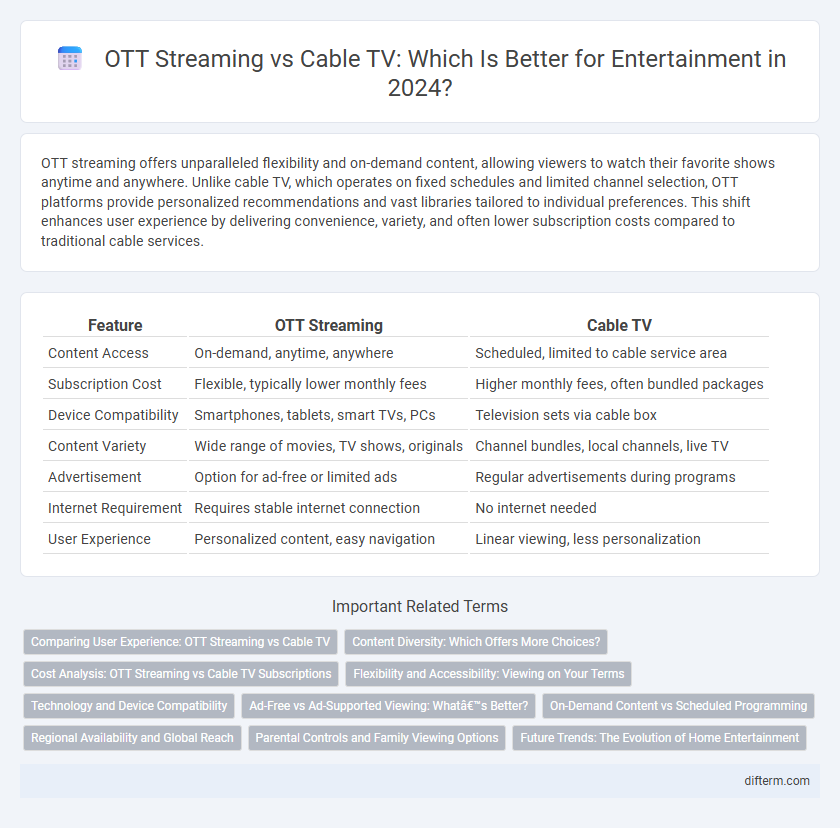OTT streaming offers unparalleled flexibility and on-demand content, allowing viewers to watch their favorite shows anytime and anywhere. Unlike cable TV, which operates on fixed schedules and limited channel selection, OTT platforms provide personalized recommendations and vast libraries tailored to individual preferences. This shift enhances user experience by delivering convenience, variety, and often lower subscription costs compared to traditional cable services.
Table of Comparison
| Feature | OTT Streaming | Cable TV |
|---|---|---|
| Content Access | On-demand, anytime, anywhere | Scheduled, limited to cable service area |
| Subscription Cost | Flexible, typically lower monthly fees | Higher monthly fees, often bundled packages |
| Device Compatibility | Smartphones, tablets, smart TVs, PCs | Television sets via cable box |
| Content Variety | Wide range of movies, TV shows, originals | Channel bundles, local channels, live TV |
| Advertisement | Option for ad-free or limited ads | Regular advertisements during programs |
| Internet Requirement | Requires stable internet connection | No internet needed |
| User Experience | Personalized content, easy navigation | Linear viewing, less personalization |
Comparing User Experience: OTT Streaming vs Cable TV
OTT streaming platforms offer personalized content recommendations and on-demand viewing, enhancing user convenience compared to cable TV's scheduled programming. IPTV services enable multi-device access, allowing users to watch content anytime and anywhere, unlike traditional cable boxes bound to a single location. The intuitive interfaces and minimal advertisement interruptions of OTT streaming significantly improve user engagement over cable TV's often cluttered channel guides and frequent commercials.
Content Diversity: Which Offers More Choices?
OTT streaming platforms provide extensive content diversity with vast libraries spanning multiple genres, languages, and exclusive Originals, surpassing traditional cable TV's limited channel-based offerings. Viewers on OTT can access on-demand movies, series, documentaries, and international content anytime, while cable TV typically restricts viewers to scheduled programming and fewer niche options. Content variety on OTT services like Netflix, Amazon Prime, and Disney+ ensures a personalized viewing experience unavailable with conventional cable subscriptions.
Cost Analysis: OTT Streaming vs Cable TV Subscriptions
OTT streaming services often provide more affordable subscription options compared to traditional cable TV, with plans typically ranging from $5 to $20 per month versus cable's average cost of $70 to $100 per month. Streaming platforms eliminate expenses such as equipment rental fees and long-term contracts, contributing to significant savings. Consumers benefit from flexible, on-demand content access without hidden charges, making OTT streaming a cost-effective alternative to cable TV subscriptions.
Flexibility and Accessibility: Viewing on Your Terms
OTT streaming platforms offer unmatched flexibility and accessibility, allowing viewers to watch content anytime and anywhere on multiple devices such as smartphones, tablets, and smart TVs. Unlike traditional cable TV, OTT services provide on-demand access to a vast library of movies, series, and live events without fixed schedules or geographic restrictions. This convenience empowers users to tailor their viewing experience around personal preferences and diverse lifestyles.
Technology and Device Compatibility
OTT streaming platforms leverage adaptive bitrate technology to deliver high-quality video across diverse internet speeds, ensuring seamless playback on smartphones, tablets, smart TVs, and gaming consoles. Cable TV relies on fixed infrastructure with set-top boxes that limit flexibility and device compatibility compared to the multi-device accessibility offered by OTT services. Enhanced device interoperability and cloud-based content delivery make OTT streaming superior in catering to modern viewing habits and technological advancements.
Ad-Free vs Ad-Supported Viewing: What’s Better?
Ad-free OTT streaming offers uninterrupted viewing, enhancing user experience by eliminating commercial breaks commonly found on cable TV. Ad-supported models on OTT provide access to content at lower or no cost but may disrupt immersion with frequent ads. Audience preference varies based on tolerance for ads and willingness to pay for a seamless entertainment experience.
On-Demand Content vs Scheduled Programming
OTT streaming platforms offer extensive on-demand content libraries, allowing viewers to watch movies, series, and shows at their convenience without adhering to fixed schedules. Cable TV primarily relies on scheduled programming, restricting viewers to pre-set times for specific shows and limiting flexibility. On-demand access through OTT enhances user control, personalizes viewing experiences, and caters to binge-watching trends that cable's linear format cannot match.
Regional Availability and Global Reach
OTT streaming platforms offer extensive regional availability by customizing content to local languages and cultural preferences, ensuring a personalized viewing experience worldwide. Cable TV remains limited by geographic infrastructure and licensing restrictions, constraining its global reach compared to OTT services. The scalability of OTT enables access to diverse international markets, surpassing cable's traditional regional boundaries.
Parental Controls and Family Viewing Options
OTT streaming platforms offer advanced parental controls with customizable profiles, content filters, and viewing time limits, enhancing family-safe entertainment more effectively than traditional cable TV systems. Cable TV often provides basic parental locks but lacks the granular control and personalized recommendations found in OTT services, limiting tailored family viewing experiences. The flexibility of OTT apps supports multi-device streaming with individual restrictions, making them superior for managing diverse family preferences and safeguarding children from inappropriate content.
Future Trends: The Evolution of Home Entertainment
OTT streaming services are rapidly transforming the future of home entertainment by offering personalized, on-demand content accessible across multiple devices, surpassing traditional cable TV's fixed schedules and limited channels. Advanced technologies such as AI-driven recommendations, 5G connectivity, and interactive features are enhancing user engagement and reshaping viewing habits. The shift towards subscription-based models, original content production, and global accessibility positions OTT platforms as the dominant force in the evolving entertainment landscape.
OTT streaming vs cable TV Infographic

 difterm.com
difterm.com